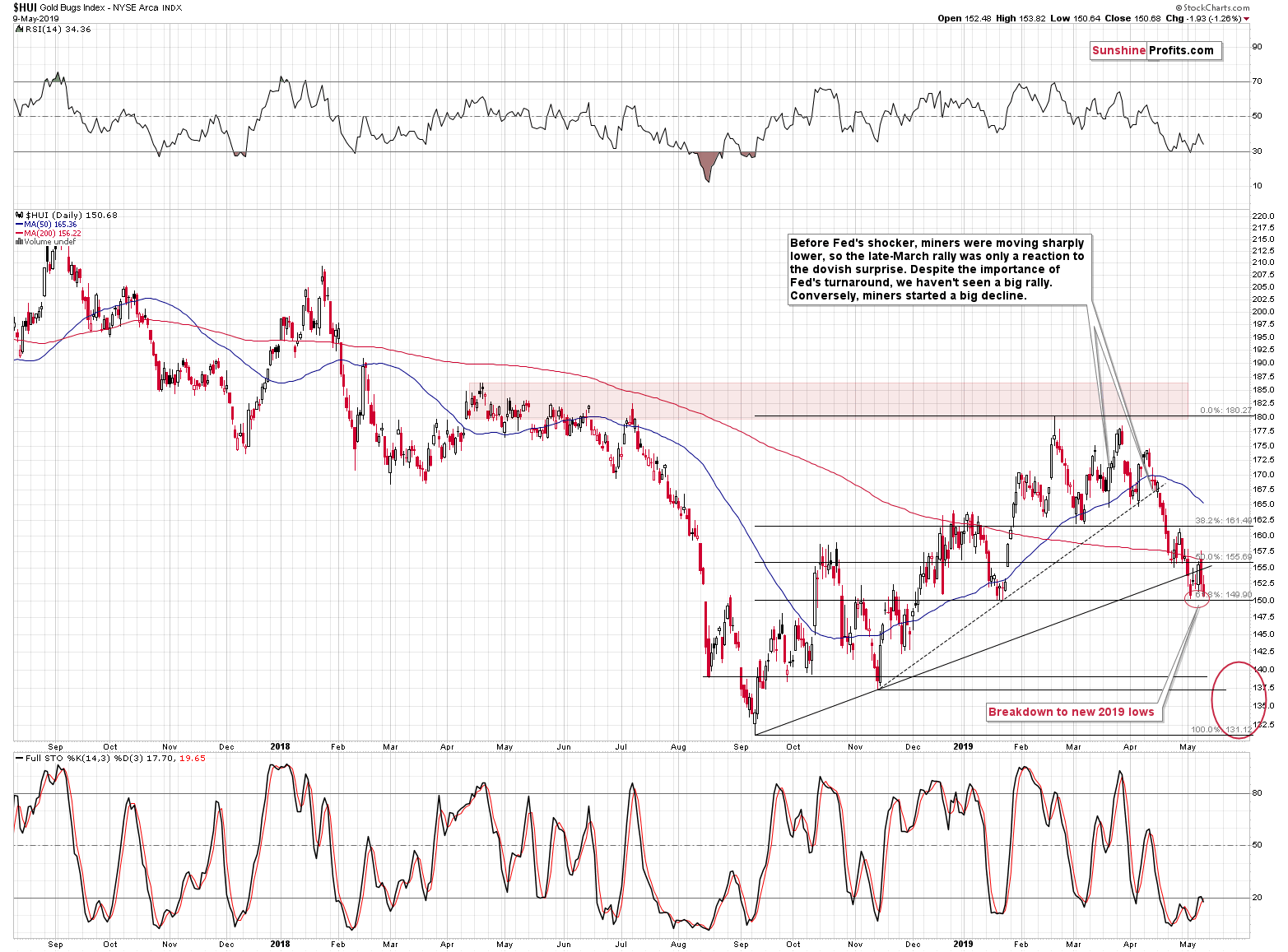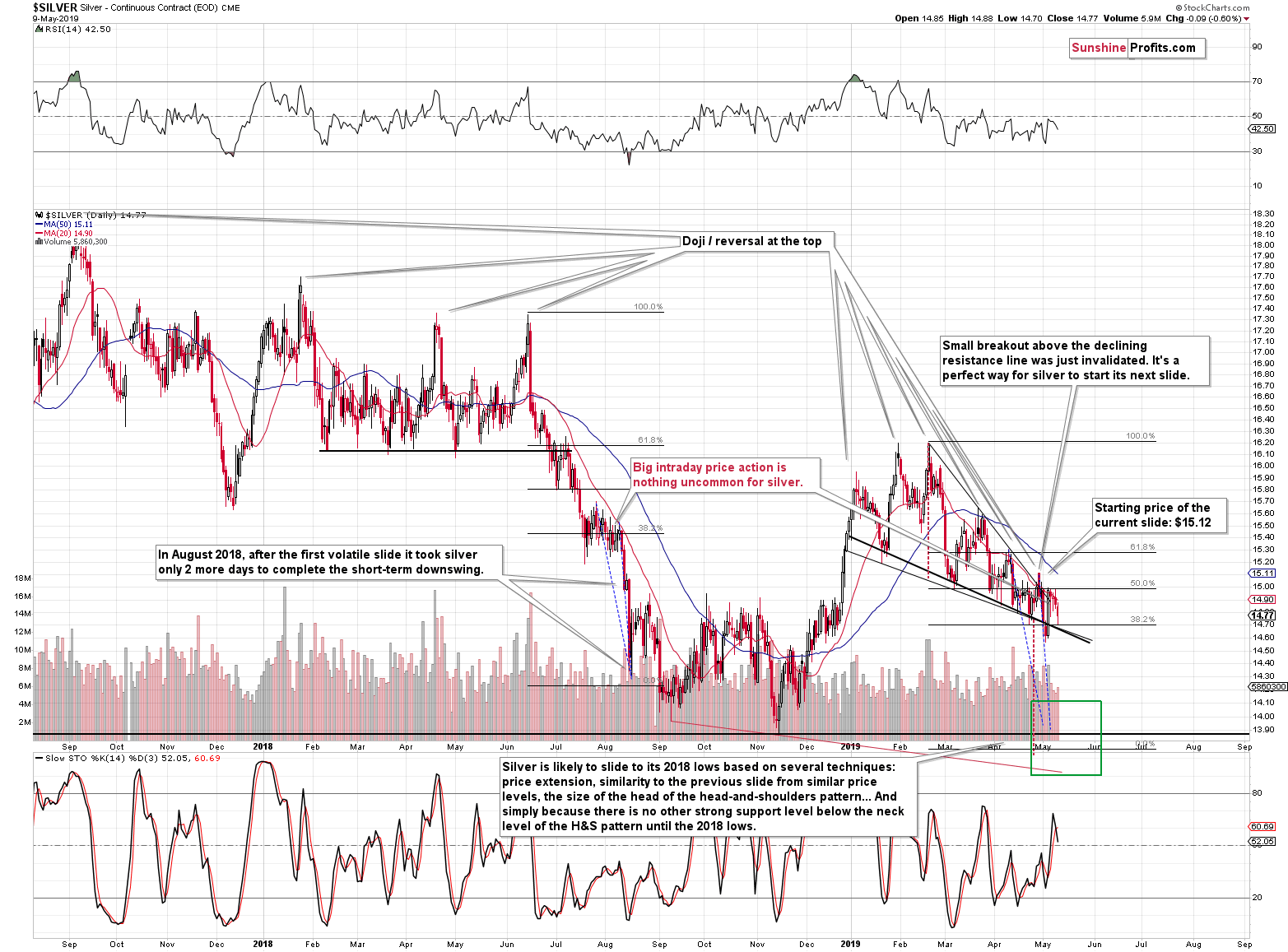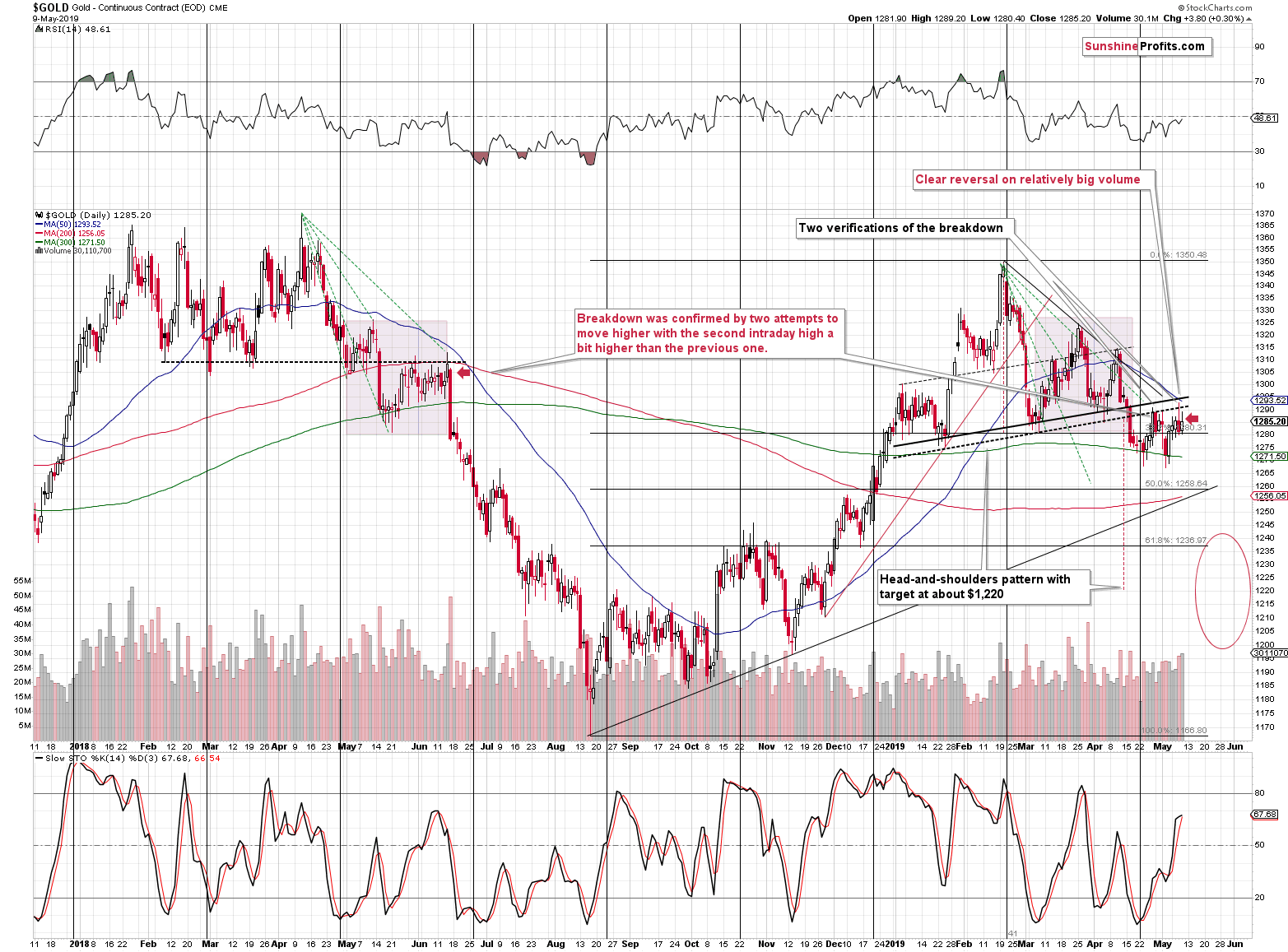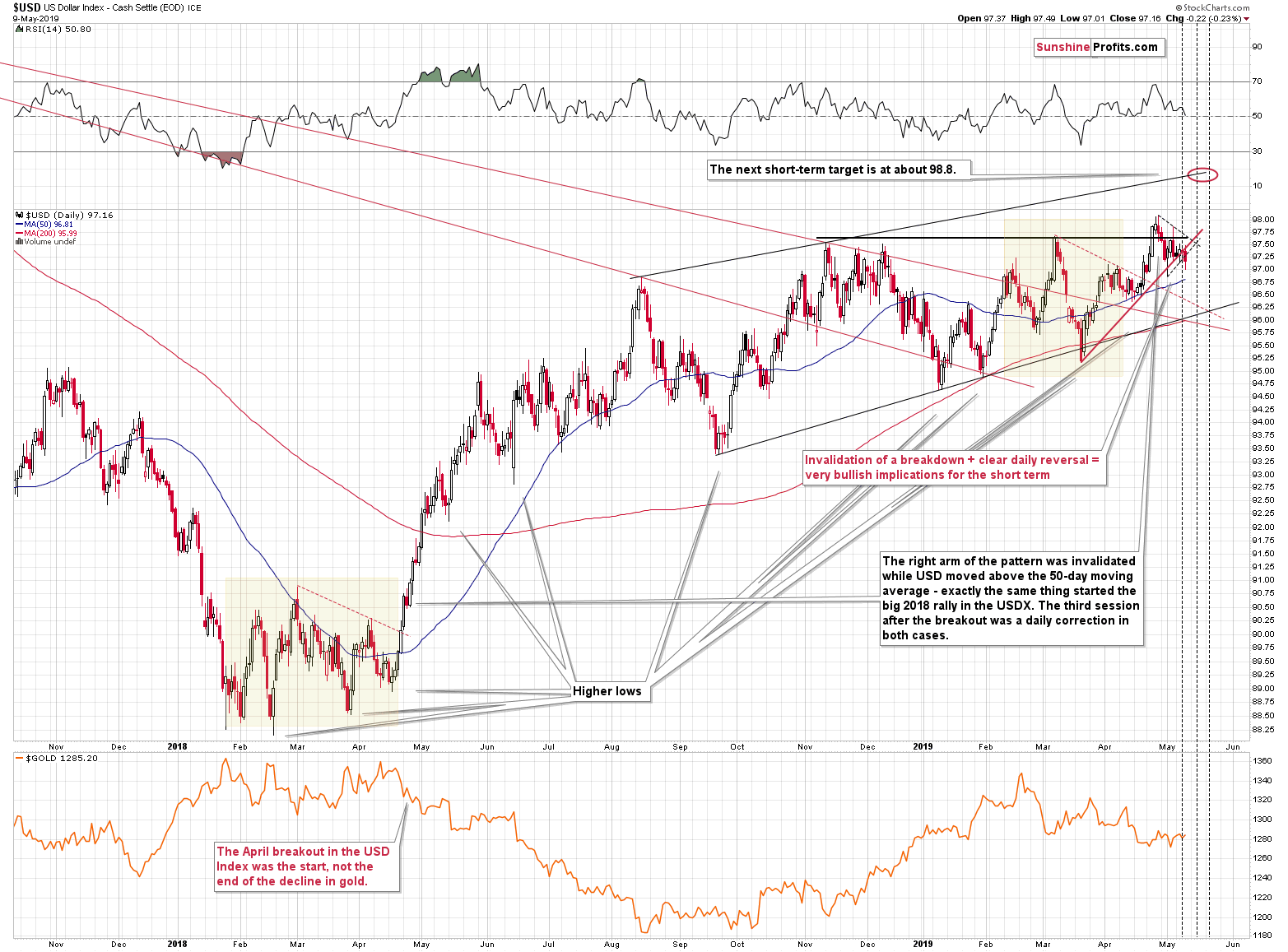Briefly: in our opinion, full (250% of the regular size of the position) speculative short position in gold, silver, and mining stocks is justified from the risk/reward perspective at the moment of publishing this Alert.
Gold stocks just broke to new 2019 lows. They have done so just two days after the supposed start of a rally. Those who were taken in by their bluff have a hard time exiting their long positions. And things will most likely get worse for them as the breakdown to new yearly lows - despite a move higher in gold - is undeniably bearish. Miners might not come back to the Wednesday's high for months. It may seem unbelievable, but just wait to see what happens in the next few days. What makes this so likely?
The relative performance of mining stocks to gold and to the action in the USD Index.
Mining Stocks at 2019 Lows
It's difficult to imagine a more bearish set-up than what we have in gold stocks right now. We saw a breakdown below a rising support line, then it was confirmed and an attempt to break back above it quickly failed. We now saw a move to new yearly lows that took place despite a move higher in gold and a move lower in the USD Index.
The situation is definitely not like what we saw in late January, so we shouldn't expect to see a rally based on just the price level. Instead, the situation is similar to what we saw in August 2018, when gold miners were already after a sizable downswing. Last year, the next turnaround materialized at about 140 level in the HUI. We expect something similar also this time. Back then, it took only two days for the miners to rise from about 140 to above 150, so please keep in mind that this kind of volatility is quite likely also this time.
Silver and Gold Are Getting Ready for the Plunge
Silver declined as well, and it confirmed the other bearish signs with a sell signal from the Stochastic Oscillator. The last time when we saw a similar sell signal in the upper half of indicator's trading range, was in late March, shortly after silver topped at about $15.70. The previous case was in February, after silver topped at about $16.20. In both cases, silver declined in a sharp manner in the following days. The implications are bearish.
Gold hasn't done anything particularly interesting - it tried to move higher once again, but didn't manage to break above Wednesday's intraday high. This means that our yesterday's comments remain up-to-date. In fact, the situation is now even more similar to what we saw in June 2018, because back then the biggest daily decline was preceded by a reversal during which gold moved higher in terms of the closing prices. That's exactly what we saw yesterday. It seems that quoting our yesterday's comments on the above chart might be useful:
We had previously marked the analogy to the 2018 decline with a blue arrow, but based on the most recent gold price movement, it seems that we are actually in a slightly different part of the analogy - earlier than previously assumed. Consequently, we adjusted the arrows on the above chart and to emphasize the change, we also changed their color to red.
We previously based the analogy on the sizes of daily moves and price levels that were reached. However, based on the shape of the recent post-breakdown consolidation it seems that the declines are similar in a bit different way. Considering the breakdowns below the previous short-term support lines (marked with black, dashed lines), we see that the post-breakdown actions are quite similar to each other. In other words, the mid-May 2018 breakdown's aftermath is similar to the mid-April 2019 one.
The May 2018 breakdown was volatile and the bottom was formed by a series of slightly lower lows. Then we saw an initial upswing back to the previously broken support line that was verified as resistance. Then another move lower, and finally, another verification of the previously broken resistance. The second intraday high (the second verification) was slightly higher than the first one.
We saw exactly the same thing recently.
The April 2019 breakdown was volatile and the bottom was formed by a series of slightly lower lows. Then we saw an initial upswing back to the previously broken support line that was verified as resistance. Then another move lower, and finally, another verification of the previously broken resistance. The second intraday high (the second verification) was slightly higher than the first one.
Back in 2018, that was just before the biggest slide and the beginning of the decline acceleration. The same thing appears likely also this time. The slide might take place today or tomorrow, but even if it doesn't, the implications will still remain very bearish.
Moreover, please note that gold just formed a bearish shooting star candlestick and it took place on relatively big volume, which is a classic way for a decline to start.
Before summarizing, let's take a look at the recent changes in the USD Index.
The USD Index Is Taking Its Time
As we wrote earlier, the USD Index declined yesterday. The move was not huge, but it was enough to break below the short-term triangle pattern and below the rising red support line. It's a bearish sign for the USD, but not really for the precious metals sector. Silver and mining stocks have just showed how much they care about USD's decline. They both moved lower anyway and the HUI Index even broke to a new yearly low. Gold moved higher, but not significantly so. Besides, gold has the strong resistance just above the current price - the neck level of the head and shoulders pattern already stopped gold's rallies twice.
The most bullish scenario would be that the reaction in the precious metals sector is simply delayed for a week, while the USDX moves lower in that time. It might even be the case that the PMs decline starts in a week or so, after options' expiration day. Yesterday's profound weakness in the miners, however, suggests that we will not have to wait that long and that the move lower will continue shortly.
Summary
Summing up, miners' recent bluff was confirmed by a move to new 2019 lows in the HUI Index, and the outlook for the precious metals sector is clearly bearish. Based on the confirmed head-and-shoulders top in gold, the building pressure in the USD Index, and the analogy to the way the precious metals market declined in 2012 and 2013, the next short-term bottom might be reached as early as this or the next week - in a volatile manner. This upcoming bottom might be a good opportunity to go long, but we are definitely not in this kind of situation right now. Conversely, in our view, short positions in the PMs are likely to generate sizable profits.
To summarize:
Trading capital (supplementary part of the portfolio; our opinion): Full short position (250% of the full position) in gold, silver, and mining stocks is justified from the risk/reward perspective with the following stop-loss orders and exit profit-take price levels:
- Gold: profit-take exit price: $1,241; stop-loss: $1,357; initial target price for the DGLD ETN: $51.87; stop-loss for the DGLD ETN $39.87
- Silver: profit-take exit price: $13.81; stop-loss: $15.72; initial target price for the DSLV ETN: $39.38; stop-loss for the DSLV ETN $26.97
- Mining stocks (price levels for the GDX ETF): profit-take exit price: $18.41; stop-loss: $24.17; initial target price for the DUST ETF: $34.28; stop-loss for the DUST ETF $15.47
In case one wants to bet on junior mining stocks' prices (we do not suggest doing so - we think senior mining stocks are more predictable in the case of short-term trades - if one wants to do it anyway, we provide the details), here are the stop-loss details and target prices:
- GDXJ ETF: profit-take exit price: $26.42; stop-loss: $35.67
- JDST ETF: profit-take exit price: $78.21 stop-loss: $30.97
Long-term capital (core part of the portfolio; our opinion): No positions (in other words: cash)
Insurance capital (core part of the portfolio; our opinion): Full position
Whether you already subscribed or not, we encourage you to find out how to make the most of our alerts and read our replies to the most common alert-and-gold-trading-related-questions.
Please note that the in the trading section we describe the situation for the day that the alert is posted. In other words, it we are writing about a speculative position, it means that it is up-to-date on the day it was posted. We are also featuring the initial target prices, so that you can decide whether keeping a position on a given day is something that is in tune with your approach (some moves are too small for medium-term traders and some might appear too big for day-traders).
Plus, you might want to read why our stop-loss orders are usually relatively far from the current price.
Please note that a full position doesn't mean using all of the capital for a given trade. You will find details on our thoughts on gold portfolio structuring in the Key Insights section on our website.
As a reminder - "initial target price" means exactly that - an "initial" one, it's not a price level at which we suggest closing positions. If this becomes the case (like it did in the previous trade) we will refer to these levels as levels of exit orders (exactly as we've done previously). Stop-loss levels, however, are naturally not "initial", but something that, in our opinion, might be entered as an order.
Since it is impossible to synchronize target prices and stop-loss levels for all the ETFs and ETNs with the main markets that we provide these levels for (gold, silver and mining stocks - the GDX ETF), the stop-loss levels and target prices for other ETNs and ETF (among other: UGLD, DGLD, USLV, DSLV, NUGT, DUST, JNUG, JDST) are provided as supplementary, and not as "final". This means that if a stop-loss or a target level is reached for any of the "additional instruments" (DGLD for instance), but not for the "main instrument" (gold in this case), we will view positions in both gold and DGLD as still open and the stop-loss for DGLD would have to be moved lower. On the other hand, if gold moves to a stop-loss level but DGLD doesn't, then we will view both positions (in gold and DGLD) as closed. In other words, since it's not possible to be 100% certain that each related instrument moves to a given level when the underlying instrument does, we can't provide levels that would be binding. The levels that we do provide are our best estimate of the levels that will correspond to the levels in the underlying assets, but it will be the underlying assets that one will need to focus on regarding the signs pointing to closing a given position or keeping it open. We might adjust the levels in the "additional instruments" without adjusting the levels in the "main instruments", which will simply mean that we have improved our estimation of these levels, not that we changed our outlook on the markets. We are already working on a tool that would update these levels on a daily basis for the most popular ETFs, ETNs and individual mining stocks.
Our preferred ways to invest in and to trade gold along with the reasoning can be found in the how to buy gold section. Additionally, our preferred ETFs and ETNs can be found in our Gold & Silver ETF Ranking.
As a reminder, Gold & Silver Trading Alerts are posted before or on each trading day (we usually post them before the opening bell, but we don't promise doing that each day). If there's anything urgent, we will send you an additional small alert before posting the main one.
=====
Latest Free Trading Alerts:
Traditional alchemist always desired to turn lead into gold. The modern ones want to increase government spending without any limits. We invite you to read our today's article about the Modern Monetary Theory and find out what is it and what would mean for the gold market, if implemented.
What is a Bigger Alchemists' Dream: MMT or Transmutation Into Gold?
=====
Thank you.
Sincerely,
Przemyslaw Radomski, CFA
Editor-in-chief, Gold & Silver Fund Manager







